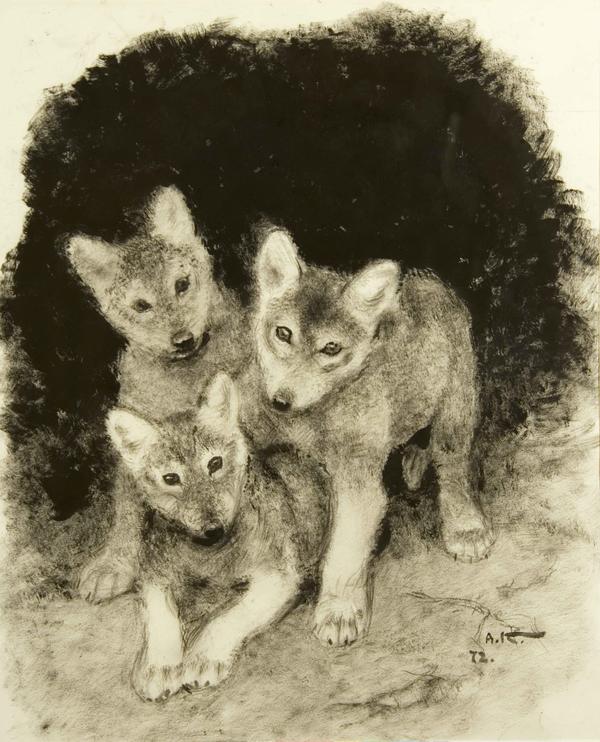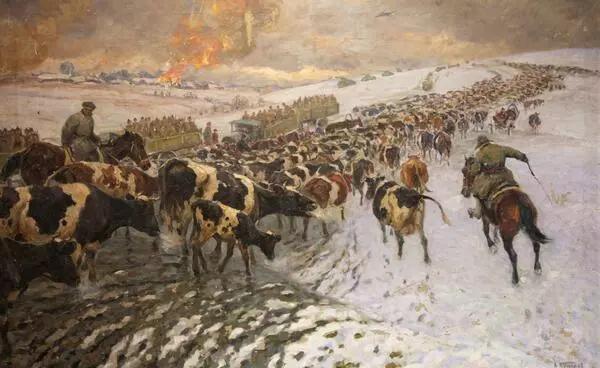Alexey Komarov (1879-1977) was a graphic artist and animal painter. Along with artists Vasily Vatagin and Dmitry Gorlov, he laid the foundations of the national animalistic school. He studied at the Moscow School of Painting, Sculpture and Architecture with the realist artist Nikolai Kasatkin, and then with the master of animalistic landscape Alexey Stepanov, whose work influenced him. The artist traveled a lot and participated in a number of expeditions, which gave him the opportunity to create sketches of various types of animals from nature. He created illustrations for children’s fairy tales, including “The Teremok”, “The Fox and the Wolf”, “Kolobok”, and for magazines such as “The Svetlyachok” and “The Murzilka”. He was engaged in the illustration of the scientific magazines “The Hunting Birds and Animals of the USSR” and “The Birds of the Soviet Union”, popular books, collaborated with publishing houses of I. Sytin, A. Stupin, later with “The Detgiz”, “The Uchpedgiz”, and “Molodaya Gvardia”.
Komarov was also engaged in the creation of posters on the theme of child health protection in the 1920s and on the topics for the Motherland protection during the Great Patriotic War. Also he made drawings for stamps and postcards and worked in the genre of animal sculpture. His numerous achievements in the artistic field were awarded the title of People’s Artist of the RSFSR in 1972.
Komarov’s paintings are kept in numerous national museum collections, including the State Darwin Museum, the Historical Museum and others.
The collection of the Tarusa Art Gallery features watercolors by Alexey Komarov and graphic drawings made in the dry needle technique. One of them is “The Wolf Cubs” from 1972, which captures a touching image of three little wolf cubs looking out of a dark hole. Despite the monochrome color scheme, the artist skillfully conveys halftones and shadows, and textures depicting animal fur. He managed to reliably reflect the characteristics inherent in a particular animal, while giving it the features of a cub for a successful embodiment in a children’s illustration. Even the emotions of the wolf cubs, looking out into the light with curiosity, are conveyed.
Komarov was also engaged in the creation of posters on the theme of child health protection in the 1920s and on the topics for the Motherland protection during the Great Patriotic War. Also he made drawings for stamps and postcards and worked in the genre of animal sculpture. His numerous achievements in the artistic field were awarded the title of People’s Artist of the RSFSR in 1972.
Komarov’s paintings are kept in numerous national museum collections, including the State Darwin Museum, the Historical Museum and others.
The collection of the Tarusa Art Gallery features watercolors by Alexey Komarov and graphic drawings made in the dry needle technique. One of them is “The Wolf Cubs” from 1972, which captures a touching image of three little wolf cubs looking out of a dark hole. Despite the monochrome color scheme, the artist skillfully conveys halftones and shadows, and textures depicting animal fur. He managed to reliably reflect the characteristics inherent in a particular animal, while giving it the features of a cub for a successful embodiment in a children’s illustration. Even the emotions of the wolf cubs, looking out into the light with curiosity, are conveyed.




